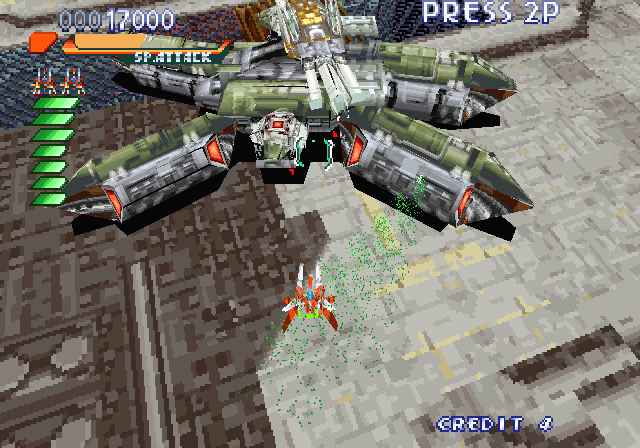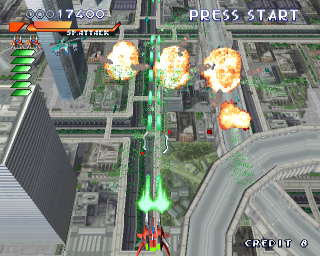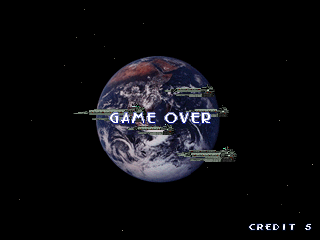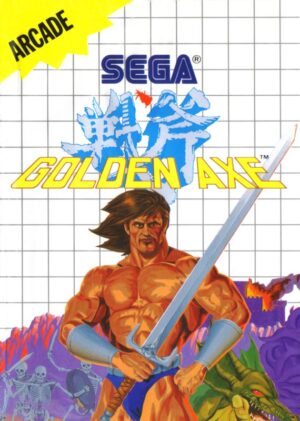Retro Replay Review
Gameplay
RayStorm delivers a classic shoot’em-up experience that blends 2D gameplay mechanics with fully realized 3D visuals. At its core, you pilot a sleek space fighter through seven meticulously designed stages, each culminating in an enormous end boss that tests your reflexes and strategic thinking. The satisfaction of weaving between enemy fire, locking onto targets, and watching your lock-on missiles explode in showers of sparks is at the heart of the game’s appeal.
(HEY YOU!! We hope you enjoy! We try not to run ads. So basically, this is a very expensive hobby running this site. Please consider joining us for updates, forums, and more. Network w/ us to make some cash or friends while retro gaming, and you can win some free retro games for posting. Okay, carry on 👍)
The arsenal at your disposal consists of a rapid-fire Vulcan cannon and a precision lock-on missile system. The Vulcan cannon offers constant, forward-firing streams of bullets—ideal for thinning out swarms of lighter enemies—while the lock-on allows you to home in on multiple targets simultaneously. Mastering the balance between these two options raises the gameplay to a tactical level, forcing you to decide when to pepper foes with bullets or unleash a devastating missile volley to clear the screen.
Beyond the basic weapons, RayStorm introduces two special attacks that add depth and spectacle. By manipulating the lock-on system in specific sequences, you can trigger a powerful area-of-effect blast or a concentrated laser beam, both capable of turning the tide in the most heated moments. The special meter fills as you destroy enemies, rewarding aggressive play and continuous target acquisition, which encourages players to stay on the offensive rather than huddling in safe spots.
The pacing is relentless yet fair. As you progress through rocky asteroid fields, futuristic cityscapes, and surreal alien environments, enemy patterns grow increasingly intricate. Each boss battle is a mini-scenario in itself, featuring multi-stage encounters that force you to adapt on the fly. For shoot’em-up veterans, the challenge is welcome; for newcomers, the gradual learning curve and generous checkpoint system ease you into the fray without feeling punishing.
Graphics
RayStorm’s hallmark is its 3D-rendered environments paired with 2D plane gameplay, a technical feat that was cutting-edge when the arcade version debuted. Though this hybrid approach may seem commonplace today, at the time it created a sense of depth and immersion rarely seen in the genre. The backgrounds rotate and shift subtly as you fly, giving the impression that you’re hurtling through dynamic space terrain rather than a static backdrop.
Enemy models and bosses are detailed and colorful, standing out sharply against often-muted backgrounds. You’ll encounter everything from clanking mechanical drones to shimmering energy orbs, each with distinct shapes and movement patterns. The boss designs are particularly memorable: massive warships, organic tentacled horrors, and crystalline constructs that tower over your fighter, all rendered with enough polygonal detail to look imposing even on the original PlayStation hardware.
Special effects elevate the spectacle, too. Lock-on missiles streak across the screen with glowing trails, while the special attacks unleash shockwaves that ripple through the environment. Explosions bloom in bursts of light and debris, and enemy projectiles leave fluid arcs of color as they home in on you. RayStorm’s visual presentation still holds up surprisingly well, thanks to its thoughtful use of color contrast and clear visual cues to highlight threats.
On home consoles like the PlayStation and Saturn, the ports maintain most of the arcade’s visual fidelity. While there are occasional frame rate dips during the busiest moments, the overall experience remains smooth and responsive. For players seeking retro visuals with a polished sheen, RayStorm stands as a testament to the ingenuity of mid-’90s arcade-to-console conversions.
Story
True to shoot’em-up tradition, RayStorm doesn’t burden you with an elaborate narrative. There’s no in-depth backstory or branching dialogue trees—instead, the game focuses squarely on action and spectacle. You assume the role of a pilot in a futuristic spacefaring force, tasked with neutralizing a rogue network of machines bent on galactic domination. It’s a familiar setup, but delivered with enough flair in the opening and end sequences to give context to your mission.
Though RayStorm is often viewed as the spiritual successor to Galactic Attack, it forgoes any direct storyline connection. Instead, it borrows the fast-paced, target-locked gameplay that defined its predecessor while charting its own course in terms of visual style and level structure. This loose lineage allows RayStorm to stand on its own merits, free from narrative expectations imposed by earlier titles.
Between stages, minimal text and simple cutscenes introduce the next threat, keeping the momentum high without interrupting the flow. This approach will appeal to purists who prefer action over exposition, though those seeking character development or plot twists may find the story elements sparse. Still, the game’s brevity—clocking in at around two hours for a first playthrough—makes it a tightly focused ride from start to finish.
In the end, the storyline serves as a functional backdrop rather than the main attraction. It’s a classic example of gameplay-first design, where narrative exists to justify the on-screen chaos but never overshadows the primary objective: shoot everything that moves and survive. For the core audience of shoot’em-up enthusiasts, this minimalist approach works perfectly.
Overall Experience
RayStorm is a thrilling blast from the past that continues to delight fans of the shoot’em-up genre. Its combination of straightforward controls, strategic weapon management, and spectacular boss encounters makes it an engaging experience from beginning to end. The tension of weaving through intricate bullet patterns while lining up lock-on missiles never grows old, and the satisfaction of clearing a screen of foes in a single salvo remains unmatched.
Replay value is strong, thanks to multiple fighter choices, branching level routes on harder difficulties, and hidden secrets tucked into each stage. Speedrunners and score-chasers will find ample reason to revisit the game, striving for flawless runs and perfect lock-on chaining to maximize their points. Casual players will appreciate the adjustable difficulty and generous checkpoint system, which strikes a nice balance between accessibility and challenge.
Despite its age, RayStorm holds up as an essential entry in the shoot’em-up canon. The 3D graphics may not rival modern titles, but the game’s design philosophy—clear visuals, tight controls, and explosive feedback—remains relevant. Ports on PlayStation and Saturn preserve the core experience, making it easy for retro gamers to jump in and appreciate what made this title a standout in the arcades.
Whether you’re a veteran seeking nostalgia or a newcomer curious about classic shooters, RayStorm delivers an adrenaline-pumping ride through space that few games of its era can match. It may not reinvent the genre, but it refines it with style and precision, offering an experience that is both timeless and emblematic of mid-’90s arcade greatness.
 Retro Replay Retro Replay gaming reviews, news, emulation, geek stuff and more!
Retro Replay Retro Replay gaming reviews, news, emulation, geek stuff and more!









Reviews
There are no reviews yet.